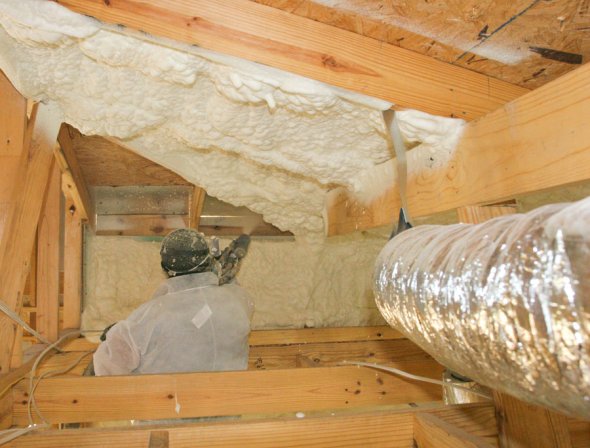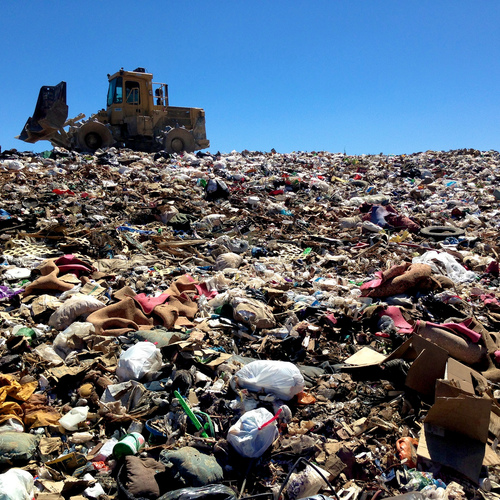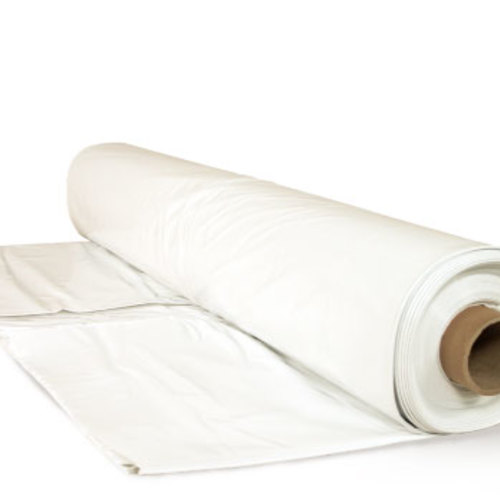
UPDATED 1/19/11 with comments from Peter Yost
Open-cell polyurethane foam expands dramatically as soon as it hits its target, rapidly filling wall cavities and typically mushrooming beyond the stud line. After it’s firmed up, installers trim away the excess so drywall or other wall finishes can be put up.
The installer who sprayed open-cell foam into the exterior walls of Peter Halkias’ house has packed up his truck and hit the road, leaving him with “bags and bags” of excess foam. Halkias knew up front that disposal would be his problem. Now he wonders what to do with it, and whether it can be broken up into finer chunks and spread over the fiberglass batt insulation already in his attic.
“Are there any code violations involved in doing this?” he asks in a Q&A post. “The only thing I can think of is an issue of flammability. The attic is fully vented and any light fixtures located in the ceiling joist bays are rated IC and airtight. I am trying to kill two birds with one stone: Get rid of the waste and add some insulation R-value to my attic ceiling.”
The replies to Halkias’ post, the subject of this week’s Q&A Spotlight, touch not only on the merits of his plan but also the knotty disposal issue in general. And like a concurrent thread elsewhere on the site, it’s an opening to discuss the potential downsides to spray-foam insulation.
First, will it work?
GBA senior editor Martin Holladay doubts much will be gained by Halkias’ plan. First, exposed foam is a fire hazard, Holladay said, and used in this way it won’t offer much in the way of insulation: “Unlike undisturbed foam that is sprayed in place,…
Weekly Newsletter
Get building science and energy efficiency advice, plus special offers, in your inbox.

This article is only available to GBA Prime Members
Sign up for a free trial and get instant access to this article as well as GBA’s complete library of premium articles and construction details.
Start Free TrialAlready a member? Log in















32 Comments
Attic Spray Foam Insulation
We like spray foam in the walls but are not as convinced in the attic thats the best way to go.
risking criticism here for challenging Anonymous Posters
I can not help but notice that "Katie" (an anonymous poster) has not returned to answer any further questions.
What insulation is truely green?
Straw, used as a building material and insulation is probably as green as it gets.
Something not promoted as much as toxic foam. Far from green...
Industry still in it's infancy...
Seems that the cart has been put in front of the horse on this one folks. all of the toxic waste and nowhere to put it... gosh, I wish I would thought of that one sooner.
Hard to imagine anyone involved in "green building" would still be on the fence with this one.
No brainer people. Toxic ain't green !
BioBased foam an alternative?
I remember reading about soybean-based foam and seeing a brief publicity blitz about it last year. I'm not in any position to judge its overall green-ness, though. Has anyone had any experience with companies that offer that service?
"a concurrent thread"
Some people have noticed that the "Not-So-Foamy" discussion is not only about Spray Foam.
It is about ALL foam products.
Edit to add soundtrack
https://www.youtube.com/watch?v=1PK2R0IwCiY
Soy Foam
All spray foam insulations are petroleum based. Including soy foam insulation. The maximum soy content in these foams is 15% and they generally cost 3 times more than regular foam insulation.
They are available in both open and closed cell with opencell naturally being less expensive. Still lots of questionable chemical stuff going on in both sides of these mixes.
Put a handful of soybeans into a gallon of oil to judge the greeness.
RobThere is not a great
Rob
There is not a great reduction in oil used in production. An applicator told me about 15% soy based.
As far as the scrap waste. I think just laying the pieces on top would do little. It is not the air move through the material it is the air moving around the material. MY thought was what about laying the foam out and then covering with cellulose, fill the voids between the foam and have a covering over the foam. Since we are talking about bats covering with cellulose should help. Plus there is probably exposed rafters and thermal bridging. This is probably better than just putting the foam in a landfill.
soy foam and off-ratio issues, proposed change to NGBS and LEEDh
We've noticed more problems with mix consistency with bio-based foams leading to persistent odor and inconsistent hardening. The quality of the training of the installation crew is a big factor here.
I've been continuing to dig deeper into the flame retardant issue and have a proposal in for the ANSI-700 NGBS re-write that is currently worded as follows:
Chapter 9 Indoor Environmental Quality 901.11 Insulation Add new as follows:
901.11 (C) Environmentally preferable flame retardant used exclusively in foam board and spray foam insulation products.
Less environmentally persistent, bio-accumulative and neuro-toxic flame retardant additives are specified and implemented exclusively such as non-halogenated, bio-degradable Triethyl phosphate (TEP) or persistent and halogenated but less toxic Tris (1-chloro-2-propyl) phosphate (TCPP).
Reason:
Many of the flame retardants currently in use have been linked to endocrine disruption and birth defects. Their absorption in to the system through dust or direct skin contact can be very rapid, long lasting, and can be associated with birth defects such as reduced birth weight and delayed secondary sexual development especially in male infants. At this point there is no incentive for flame retardant manufacturers to disclose which of the legally allowable chemicals they use in their products so consumers have difficulty identifying preferable products as the MSDS sheets list flame retardant composition as "trade secret."
Offering point credit for products that can verify that preferable chemicals were used could lead to a premium class of flame retardants in foam insulation panels and in spray foam both open and closed cell, as well as home furnishings foam, carpet and fabrics, and could help ensure the health of future generations as well as the children born in these cleaner homes.
Point credit?
What point credit? Is there such a carrott to dangle? At whose expence?
Dangerous chemicals will remain dangerous chemicals~ I don't get the point.
Point credit
Roy the idea I'm proposing here is to use the National Green Building Standard and LEED-h as incentives to convince industries that are required by law to add flame retardants to their products (Board foam, Spray foam, Carpet, Carpet pad, Laptop computers, Televisions, foam upholstered furniture, curtains, etc. ad nauseum. to stop listing "trade secret" as the fire retardant of choice in their MSDS reports and start actually disclosing what they are using and eventually use market forces to encourage them to use less toxic and environmentally persistent and accumulative products.
There are many people here who are not aware of the hazards involved with building or furnishing a home. Those who are aware that , for instance the computer I am typing this on is loaded with flame retardant, or that the chemical content of the spray foams, board foams, carpet or flooring products I use in my homes are rarely disclosed in the MSDS report.
Some may simply decide to live without TVs, computers, cars, foam products or uphlstered furniture but there is power here to encourage more open disclosure and move the industry to find and use environmentally preferable solutions. They have no incentive if there is no disclosure or no market. LEED-h and ANSI-700 NGBS were designed to effect market change. Both are in re-write at this time. Now is our chance to raise the bar to those definitions of green and move us towards a less toxic solution.
It is legal to hide the presence of toxic elements in your products behind the "trade secret" mask in the MSDS. Making certain chemicals illegal has been disastrous, we are faced with endocrine disrupting and bio-accumulative halogenated flame retardants because previous flame retardants were found to be carcinogenic so the legislators demanded that industry find replacements that are not carcinogenic. Rather than say "don't use this" with out offering an alternative we are better served by finding a preferable solution and encouraging the industry to switch.
I'm done making babies, this is not about me. It doesn't matter if I take a nap on an upholstered sofa or wrestle with my kids on a nice new carpet. It matters to future generations, and the path to a less toxic marketplace is through codes and standards. LEED and NGBS may not be "green" by the measure of the majority of folks on this site but they have great sway in the market. they are the tools we can use to implement change.
Point Credit
Thanks for the explanation Michael,
If trade secrets can be revealed on MSDS papers that would be a step in the right direction.
I would venture a guess that most consumers don't know what a MSDS sheet is though. Still, having the truth in writing would create a degree of accountability that does not exist now.
Good idea.
foam
I understand that that people want to use foam for performance reasons, but all he negatives greatly outweigh that performance. the unknown effects of the chemicals, the lack of bio-availability for future decomposition, waste disposal issues, fire hazard(I didn't know this) and the most overlooked, future deconstructibility. A foamed house has been essentially glued together rendering all framing and sheathing components unsalvagable in the future, which guarantees more wastes in a land fill.
Even SIPs have some potential for being reused at some point, though they have their drawbacks.
There seems a constant struggle against market forces which may move us towards one goal(a buildings energy efficiency) but away from others, like sustainable material loops.
Spray Foam
Mr. John Brooks -- allow "Katie" to introduce herself. I am the marketing manager for Tridon Industries, an installer of spray foam and other types of insulation, as well as fireproofing, in residential and commercial applications. We are based in suburban Philadelphia, and service the Northeast and Mid-Atlantic regions. Pleased to meet all of you!
I haven't found a way to "follow" this thread, or set it up as an RSS feed, so therefore have had to rely on my memory to bring me back here for further comments. Also, it seems the first time I commented, I got so wrapped up in the swirl of the conversation I neglected to attribute myself. My apologies.
We've been installing spray foam for nearly a decade, and in that time have installed just about every product from every manufacturer you can think of. We were installing spray foam long before it became the popular thing to do, and long before the "green" movement became de rigueur, because we believed in it. And we still do, for all its benefits. Of course you need to maintain perspective -- Installing spray foam is no more hazardous than crab fishing or mining for coal (jobs we still deem essential), in that there is the potential for illness and toxicity and long-term side effects. It's all about having a work force that is trained and knowledgeable and protected as best as possible against danger.
In nearly a decade of spraying foam, however, we've had little complaint from any customer, other than the smell, from allergy/asthma sufferers. The vast majority of our customers are pleased with the outcome -- lower energy bills, less drafts, etc. We still believe that spray foam is more a nuisance to installers when it's being applied than the cured foam is to building occupants once the job is all said and done. That being said, we continue to push the manufacturers we deal with for disclosure on such things as chemical ingredients and soy content, and find that they're starting to come around. Mr. Harmon / Mr. Chandler: I thought you might find that tidbit especially encouraging.
We welcome any open dialog about spray foam--good and bad--as the industry continues to grow.
Katie McVay
Marketing Manager
Tridon Industries
Response to Katie McVay
Katie,
Once again, I'd like to thank you for your comments.
I will Second That
Katie,
Thank you for your comments.
I thought you were a hit and run poster.
It turns out that you are not.
thank you for returning and responding to my questions.
Foam Alternatives
Discussion on landfill and toxin issues of foam has been great. These are detriments to foam, in addition to the fact that in many cases installed foam is compromised due to environmental conditions during installation, shrinkage, and air-leakage. (yes there is leakage if not installed properly) All told these facts re-enforce my thoughts that cellulose in walls and attic is the best choice.
Spray Foam Versus Blown Cellulose
My preference is Dense Packed Blown Cellulose because of all the complications, doubts, hassles and environmental impacts of spray foam. I'd be curious to hear others thoughts on the comparison between cellulose and spray foam.
Response to Kurt
Kurt,
If you use the "search" feature on the GBA Web site, you'll find plenty of articles and Q&A discussions on cellulose vs. spray foam.
open cell waste
Our industry has been looking for the magic answer as to what to do with open cell cutoffs, and in fact, there is a current article in Spray Foam magazine dealing with this issue. I hope as the problem is discussed further, someone does find a solution. My primary concern of course is that anything that lands on the floor does so at great cost to the contractor, as the typical 3500sf home sees hundreds of dollars worth of material (OC) go in the dumpster, in the form of offcuts.
As for leaving jobsites with all of the cutoffs, it's virtually impossible, and anyone who expects a spray foam contractor to do so on every job lacks intimate knowledge of the business of an SPF contractor. Spraying a different large job every day generates enough waste that the contractor would need a full time waste disposal crew with truck(s). Then the foam would end up being disposed of through the same channels as the homeowner or GC would, so we'd all rather pass the savings along. If we're asked to take it, by all means, we'll arrange a dumpster at the jobsite's expense, but just about every person I've met would rather not pay hundreds of dollars for this service. And I would hope to be spared the argument that only multimillion dollar businesses with full time garbage crews, multiple dumpsters, etc. should engage in spray foam. Small businesses, besides being the lifeblood of the country, bring a wealth of experience, knowledge, and personalized service/attn. to detail to the table that most larger competitors can't match.
Response to Steve Richards
Steve,
The fact that you feel that removing the waste generated by your work from the job site would be "virtually impossible" doesn't speak well of the industry.
When I worked as a contractor, I was responsible for all the waste generated on the job site, and I expected the same from other contractors working there. Like you, I hope that "someone finds a solution" to this problem. In the meantime, I think two first steps would be for contractors to endeavor to minimize the foam that expands beyond the studs, and to take responsibility for cleanup and disposal.
flammability
I forgot to mention... I understand that spray foams are recognized as a combustible material, and I by no means dispute that. However, I would suggest that anyone commenting on flammability of spray foams at least try burning a sample. Most commercially applied spray foams will not support a flame once an ignition source is removed, and it is a source of struggle for our industry that we are placed in the same category as much more dangerous products such as expanded polystyrene (EPS - the white stuff, which burns, melts into a liquid, etc). I'd like to see a realistic understanding among the building community as to the combustible nature of polyurethane/polyiso vs polystyrene foams.
open cell waste
Why can't these scraps be placed in a cavtiy/bay and sprayed over?
Response to Mark Brannkarr
Mark,
You asked, "Why can't these scraps be placed in a cavtiy/bay and sprayed over?"
1. Most spray foam installations are in wall cavities or sloped ceilings, where gravity would prevent your proposal from being carried out.
2. While your proposal would work on an attic floor, most attic floors are insulated with less expensive insulation materials like cellulose.
foam scrap
I see no problem with blowing cellulose over foam scrap in a flat ceiling attic. I do it regularly.
In my business, I never use two part spray foam. I am a retrofitter and much of my air sealing effort uses one part foam and rigid foam board that is mostly isocyanurate. I generate scrap and I will not throw this stuff in the dump. In houses with 3-6" of existing insulation, I lay the scraps flat and blow at least 6" over them. In my case, the foam might replace 25 pounds of cellulose at the most. I do the same with scrap fiberglass with the kraft removed.
I have never seen how much waste is generated in a new construction wall foam project but if it could be covered with enough cellulose, I see no good reason to put it in the landfill. I don't think it will do any good to spread it over existing fiberglass batts and blown fiberglass should be banned.
Several years ago some local firefighters were called to a house fire. The homeowner worked in a shipping department of a local business and had saved used foam peanuts and packing foam and then put it in his attic. It was the only insulation in the attic and the only ceiling was the grid type that is used mostly in commercial buildings. The foam in the attic melted before it burned and the stuff dripping thru the ceiling made it very difficult for the firefighters.
Hmmm...
Steve, do you not see anything backwards in this shoot first, ask questions later approach that the industry takes?
Incinerator vs. landfill for foam scraps?
Here in Maine, our municipal waste - that which cannot be recycled (or that which people are too lazy to separate out), is hauled to an incinerator and burned, the gases scrubbed of toxins in the smokestack. Or so they assure me. The energy thus released is used to generate electricity - though that source ends up being only 0.9% of the electrical energy source for our domestic use.
The above discussion of the end-of-the-line for waste foam consistently references landfill disposal.
I don't know how common electricity-generating municipal waste incinerators are nationally, so this option may not be readily available in other communities. But I'm hoping that tossing my foam waste into that hopper is "better," all things considered, than putting them in a landfill.
I went through great knashing of teeth in considering how to insulate our basement; David Lanfear's comment reflects strongly one of my major concerns: how foaming renders an otherwise innocuous assembly of house parts unrecyclable, unusable and toxic upon deconstruction.
I am in the process of cleaning out and renovating a "basket case" of a house (not our home), formerly belonging to compulsive hoarders. As a hopelessly compulsive recycler, I wish to render each "trash" item to its highest and best use, even bits of wood. It is AMAZING how little actually ends up in our landfill when the contents are disposed of conscientiously. In my perspective, we are indeed borrowing the Earth from our grandchildren and have an obligation to take good care of it. There is no "away," as in "throw away." It takes more time, but when considering the value of my time, I consider it in the context "as opposed to the value of the environment which I affect." The environment usually comes out ahead in priority.
This discussion is a VERY IMPORTANT one that needs to take place, and the problems discussed regarding the use of foams need to be addressed in such a way as to minimize damage to the earth and our environment at all phases of the product's "life."
Spray foam
idea, though dealing with scrap is an issue one result would be to grind it up and than blend back into componets for spray at next site or onsite. Now understand this is only an idea that comes form dealing with polyester scrap and thermoset scrap (think bondo) in that this scrap now acts as a filler.
again testing and research must be done, more from suppliers side.. May change density, but would be worth testing..
recycling poly offcuts
These offcuts could be collected and stabilized in additional foam, or in large fabric wrapped bales. Then used as lightweight fill in large architectural projects. Such as buildings' planter areas, freeway interchanges, large concrete formworks.
Foam waste as soil amendment
I am curious if open cell foam waste could be used as a soil amendment. I wouldn't break down so it offers body to soils like clay and it holds water so it would release it slowly instead of draining away. This might allow one to "feed two birds with one scone".
Also, I haven't heard anyone talk about Airkrete in the foam discussion. It also fills the cavity, offers a minimal air barrier, offers sound deadening and is fire retardant. It doesn't provide as high an R-value as petro-foam, but at least is not toxic and it's waste components make disposal less alarming. I have been in the room while it was being sprayed and it smelled like the ocean, but it didn't cause any discomfort. Anyone have any experience with this product?
What I did with scrap / cut off insulation
I have been storing scrap / off cuts of 1" and 2" thick polyiso and XPS boards (not scrap spray foam off cuts).
So this past weekend used these scraps to rough fill the interior of a 200 sq ft 2x4 wall. I stuck the scraps onto the nails that were sticking through the inside of the sheathing. I left about 1" to 2" gap around the edge between the insulation and the studs (with hindsight only about 3/4" to 1" was needed). I did not expect this by itself to help with air sealing or even add 1 to the R value of the wall.
Then I used 200 board feet of 2 part foam to foam in place the rigid scraps of XPS and polyiso.
I used the scraps to fill the bulk area, and new spray foam to air seal around and bind the scraps in place. Thus I filled about 3" deep on average over 200 sq ft, that would have normally used 600 board feet of new foam, but only needed 200 board feet of new foam. Thus saving over $300 in spray foam, resources, and saving from land fill a load of polyiso and XPS, at the cost of about a man day of labor. (I value my labor above that so maybe I lost on this deal, but I'm happy with the outcome).
This was the first time that I had used 2 part spray foam myself (I had watched contractors use it before).
The down side is that I needed to inspect after for a few holes that I missed, and it was labor intensive to pack the wall with the scraps. I suspect I'll use about 2 cans of 1 part foam to touch up a few places I didn't do so well (probably only because I was inexperienced with using 2 part foam).
This is actually the second wall I have packed with scrap insulation. The first I tried using expanded polystyrene peanuts that I accumulated free over years from various packing materials (I only had enough for one 2x4 bay then).
I think that if insulation cut offs are embedded in the middle of other insulation then it can work well to reduce the volume of new insulation, but it needs to be surrounded with new insulation.
foam in the attic
I built my ICF home back in 2005. The attic has a 7 inch layer of expanding foam sprayed into a standard 4:1 truss roof. I then threw about a foot of scrap foam onto this layer of virgin material. To prevent animal and fire risk, we blew 12 inches of fibreglass to make a sandwich. So all together, there are 3 layers. Base layer is the expanding foam, middle is scrap foam from my site and others, and top sealing layer is the 12 inches of fiberglass. Note that one of the best things we did was build a runway through the attic for the workers (and myself) to work from. I am pretty sure I got a lot more than 12 inches of fibreglass, as the installer just blew the stuff in until it reached my runway. My table napkin estimate is R65 in the eaves to R80 in the centre. Checked it last year and there was no sign of settling.
Log in or become a member to post a comment.
Sign up Log in